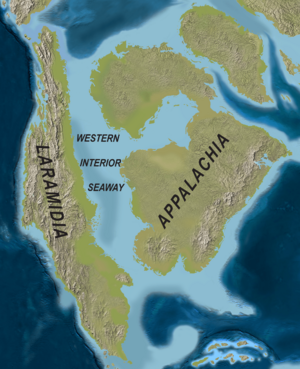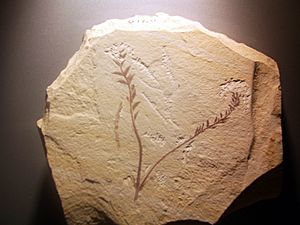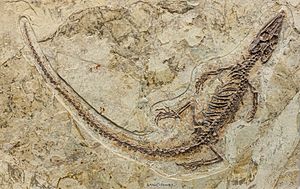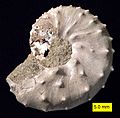Cretaceous facts for kids
Quick facts for kids Cretaceous |
|
|---|---|
| ~145.0 – 66.0 Ma | |
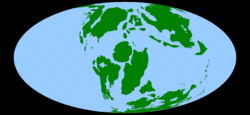
A map of the world as it appeared during the Early Cretaceous, c. 105 Ma
|
|
| Chronology | |
|
Cretaceous graphical timeline
-140 —
–
-130 —
–
-120 —
–
-110 —
–
-100 —
–
-90 —
–
-80 —
–
-70 —
–
Subdivision of the Cretaceous according to the ICS, as of 2022.
Vertical axis scale: millions of years ago. |
|
| Etymology | |
| Name formality | Formal |
| Usage information | |
| Celestial body | Earth |
| Regional usage | Global (ICS) |
| Time scale(s) used | ICS Time Scale |
| Definition | |
| Chronological unit | Period |
| Stratigraphic unit | System |
| Time span formality | Formal |
| Lower boundary definition | Not formally defined |
| Lower boundary definition candidates |
|
| Lower boundary GSSP candidate section(s) | None |
| Upper boundary definition | Iridium-enriched layer associated with a major meteorite impact and subsequent K-Pg extinction event |
| Upper boundary GSSP | El Kef Section, El Kef, Tunisia 36°09′13″N 8°38′55″E / 36.1537°N 8.6486°E |
| Upper GSSP ratified | 1991 |
The Cretaceous was a very long geological period. It lasted from about 145 to 66 million years ago. This makes it the third and final period of the Mesozoic Era. It is also the longest geological period in the entire Phanerozoic Eon. The name "Cretaceous" comes from the Latin word creta, which means "chalk". This is because a lot of chalk formed during this time.
The Cretaceous period had a generally warm climate. This led to high sea levels. Many shallow inland seas covered parts of the continents. These oceans were home to amazing marine reptiles, ammonites, and other sea creatures. On land, dinosaurs were still the main animals.
The world had almost no ice during the Cretaceous. Forests even grew near the North and South Poles. New types of mammals and birds also started to appear. Early in the Cretaceous, flowering plants began to grow and spread quickly. By the end of the period, they were the most common plants on Earth. Older plant groups, like gymnosperms, became less common.
The Cretaceous period ended with a huge event. This was the Cretaceous–Paleogene extinction event. Many groups of animals, including non-avian dinosaurs, pterosaurs, and large marine reptiles, died out. Scientists believe this was caused by a giant asteroid hitting Earth. This impact created the Chicxulub crater in the Gulf of Mexico. The end of the Cretaceous is marked by a special rock layer. This layer is called the Cretaceous–Paleogene boundary (K–Pg boundary). It shows the change from the Mesozoic to the Cenozoic Eras.
Contents
What Does "Cretaceous" Mean?
The name "Cretaceous" was first used in 1822. A Belgian geologist named Jean Baptiste Julien d'Omalius d'Halloy defined it. He called it the Terrain Crétacé. He used rock layers in France to describe it. The name comes from the Latin word creta, meaning "chalk". This is because a lot of chalk was found in the rocks from this time. Chalk is made from tiny shells of sea creatures.
How Do Scientists Divide the Cretaceous Period?
The Cretaceous period is split into two main parts. These are the Early Cretaceous and the Late Cretaceous. Scientists also divide it into 12 smaller time units. These are called "stages." Each stage is named after a place in Europe where its rocks were first studied.
Here are the main stages of the Cretaceous, from newest to oldest:
| Epoch | Stage | Start (base) |
End (top) |
Definition | Etymology |
|---|---|---|---|---|---|
| (Mya) | |||||
| Late Cretaceous | Maastrichtian | 72.1 ± 0.2 | 66.0 | top: iridium anomaly at the Cretaceous–Paleogene boundary base:first occurrence of Pachydiscus neubergicus |
Maastricht Formation, Maastricht, Netherlands |
| Campanian | 83.6 ± 0.2 | 72.1 ± 0.2 | base: last occurrence of Marsupites testudinarius | Champagne, France | |
| Santonian | 86.3 ± 0.5 | 83.6 ± 0.2 | base: first occurrence of Cladoceramus undulatoplicatus | Saintes, France | |
| Coniacian | 89.8 ± 0.3 | 86.3 ± 0.5 | base: first occurrence of Cremnoceramus rotundatus | Cognac, France | |
| Turonian | 93.9 ± 0.8 | 89.8 ± 0.3 | base: first occurrence of Watinoceras devonense | Tours, France | |
| Cenomanian | 100.5 ± 0.9 | 93.9 ± 0.8 | base: first occurrence of Rotalipora globotruncanoides | Cenomanum; Le Mans, France | |
| Early Cretaceous | Albian | 113.0 ± 1.0 | 100.5 ± 0.9 | base: first occurrence of Praediscosphaera columnata | Aube, France |
| Aptian | 121.4 | 113.0 ± 1.0 | base: magnetic anomaly M0r | Apt, France | |
| Barremian | 125.77 ± 1.5 | 121.4 ± 1.0 | base: first occurrence of Spitidiscus hugii and S. vandeckii | Barrême, France | |
| Hauterivian | 132.6 ± 2.0 | 125.77 ± 1.5 | base: first occurrence of Acanthodiscus | Hauterive, Switzerland | |
| Valanginian | 139.8 ± 3.0 | 132.6 ± 2.0 | base: first occurrence of Calpionellites darderi | Valangin, Switzerland | |
| Berriasian | 145.0 ± 4.0 | 139.8 ± 3.0 | base: first occurrence of Berriasella jacobi (traditionally); first occurrence of Calpionella alpina (since 2016) |
Berrias, France | |
The End of the Cretaceous: A Big Impact
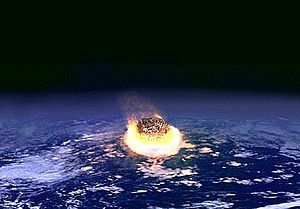
The end of the Cretaceous period is very clear in the rock record. There's a special layer of rock found all over the world. This layer has a lot of a rare element called iridium. Scientists believe this iridium came from a giant asteroid that hit Earth. This impact happened about 66 million years ago. It formed the Chicxulub crater in Mexico.
This huge impact likely caused the Cretaceous–Paleogene extinction event. This event led to the disappearance of three-quarters of Earth's plant and animal species. Many groups, like non-avian dinosaurs, pterosaurs, and large marine reptiles, died out. It took a very long time for life on Earth to recover.
Animals that ate plants and plankton died out. This happened because their food sources disappeared. Then, top predators like Tyrannosaurus rex also died. But some animals survived. These included omnivores (animals that eat both plants and meat), insectivores (insect-eaters), and animals that ate dead things. Many small mammals and birds survived this way.
Animals living in streams also did well. Stream communities often rely on dead plant and animal matter. This helped them survive the big changes. Crocodiles and similar reptiles also survived. They could live in water, eat dead things, and go without food for a long time.
What Was the Earth Like?
During the Cretaceous, the Earth's continents were still moving apart. The supercontinent Pangaea had already started to break up. The Atlantic Ocean got wider. Mountains continued to form in North America.
Gondwana, the southern supercontinent, broke apart quickly. South America, Antarctica, and Australia separated from Africa. This created the South Atlantic and Indian Oceans. These changes caused sea levels to rise around the world.
In North America, a huge inland sea formed. It split the continent into two landmasses. One was Laramidia in the west, and the other was Appalachia in the east. This sea later disappeared, leaving behind thick layers of marine rock and coal.
The Cretaceous is famous for its chalk deposits. More chalk formed during this period than any other. This is because the oceans had more calcium. Tiny sea creatures called coccolithophores used this calcium to build their shells. When they died, their shells formed thick layers of chalk.
Also, half of the world's petroleum reserves formed during this time. This happened in areas where deep sea currents were slow. This caused low-oxygen conditions. Dead organic matter didn't break down and turned into oil and gas.
Cretaceous Climate: Warm and Wet
The climate during the Cretaceous changed over time. It started cool and dry, then became warm and wet. Finally, it cooled down again. The Earth was generally much warmer than today.
During the middle of the Cretaceous, it was very hot. This period is called the Mid-Cretaceous Hothouse. Global temperatures were much higher. Even the poles were warm, with average temperatures above 14 °C (57 °F). This meant there wasn't a big temperature difference between the equator and the poles.
Because of the warm temperatures, global winds were weaker. This led to less ocean mixing. The oceans became more stagnant. This is why we find many black shale rocks from this time. These rocks formed in low-oxygen waters.
Towards the end of the Cretaceous, the climate started to cool down. This was due to less carbon dioxide in the atmosphere. However, there were still some short periods of warming. One of these was caused by massive volcanic eruptions. These eruptions formed the Deccan Traps in what is now India.
What Plants Lived in the Cretaceous?
Before the Cretaceous, plants like cycads and conifers were common. But during the Cretaceous, flowering plants (angiosperms) appeared. They quickly became the most common plants on land. Today, flowering plants make up about 90% of all plant species.
The oldest known flowering plant fossils are from about 134 million years ago. One of the oldest is Archaefructus from China. The first grasses also appeared during the Cretaceous. Large flowering trees grew as tall as 50 meters (164 feet). Ferns also became more diverse during this period.
What Animals Lived on Land?
On land, mammals were generally small. But they were an important part of the animal life. They included different types of early mammals. Some were carnivores, some ate plants, and some ate insects.
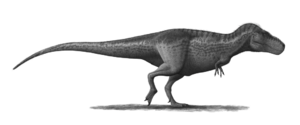
The top predators were dinosaurs. They were at their most diverse during the Cretaceous. Dinosaurs lived on every continent, even near the poles. Birds, the ancestors of modern birds, also became more diverse.
Pterosaurs, the flying reptiles, were common early in the Cretaceous. But their numbers declined later in the period. By the end, only a few specialized families remained.
An important fossil site in China, the Yixian Formation, shows us what life was like in the Early Cretaceous. It has many small dinosaurs, birds, and mammals. Some of these dinosaurs, like dromaeosaurs, had hair-like feathers.
Insects also became more diverse. The oldest known ants, termites, and some types of butterflies and moths appeared.
-
Tyrannosaurus rex, one of the largest land predators of all time, lived during the Late Cretaceous
-
Up to 2 m long and 0.5 m high at the hip, Velociraptor was feathered and roamed the Late Cretaceous
-
Triceratops, one of the most recognizable genera of the Cretaceous
-
The azhdarchid Quetzalcoatlus, one of the largest animals to ever fly, lived during the Late Cretaceous
-
Confuciusornis, a genus of crow-sized birds from the Early Cretaceous
-
Ichthyornis was a toothed, seabird-like ornithuran from the Late Cretaceous
Other Land Animals
Rhynchocephalians are a group of reptiles that today only includes the tuatara. They became less common in North America and Europe during the Cretaceous. But they remained diverse in South America.
Choristoderes were freshwater reptiles. They became very diverse in Asia during the Early Cretaceous. Some had long necks, like Hyphalosaurus. Others looked like modern gharials.
What Animals Lived in the Sea?
In the oceans, modern sharks, rays, and bony fish became common. Marine reptiles were also important. Ichthyosaurs lived in the early and middle Cretaceous. Plesiosaurs were around for the whole period. And huge mosasaurs appeared in the Late Cretaceous. Sea turtles also lived during this time.
Baculites, a type of ammonite with a straight shell, was common. Reefs were built by a type of clam called rudists. Tiny shelled creatures called foraminifera and echinoderms like sea urchins also thrived.
The first diatoms, a type of algae with glass-like shells, appeared in the oceans. Tiny calcareous nanoplankton were also very important. They helped form the chalk deposits.
-
A scene from the early Cretaceous: a Woolungasaurus is attacked by a Kronosaurus.
-
Tylosaurus was a large mosasaur, carnivorous marine reptiles that emerged in the late Cretaceous.
-
Strong-swimming and toothed predatory waterbird Hesperornis roamed late Cretacean oceans.
-
The ammonite Discoscaphites iris, Owl Creek Formation (Upper Cretaceous), Ripley, Mississippi
-
Cretoxyrhina, one of the largest Cretaceous sharks, attacking a Pteranodon in the Western Interior Seaway
See also
 In Spanish: Cretácico para niños
In Spanish: Cretácico para niños
- Mesozoic Era
- Cretaceous-Paleogene extinction
- Chalk Group
- Cretaceous Thermal Maximum
- List of fossil sites (with link directory)
- South Polar region of the Cretaceous


